Spiny Rice-flower
Spiny Rice-flowerPimelea spinescens spinescens | |
|---|---|
| Kingdom: | Plantae |
| Phylum: | Magnoliophyta |
| Class: | Magnoliopsida |
| Order: | Malvales |
| Family: | Thymelaeaceae |
| Status | |
| Australia: | Critically endangered (EPBC Act 1999) |
| Victoria: | Critically endangered (FFG Threatened List 2025) |
| FFG | Action Statement No. 132 |
| EPBC | Species Profile & Threats Database |
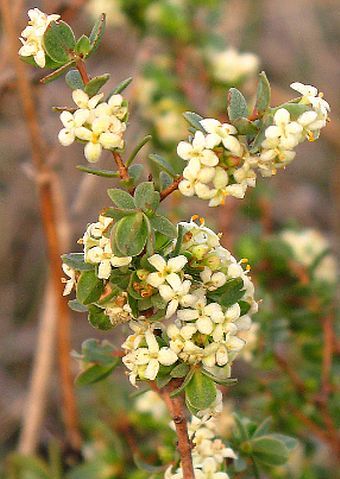
Pimelea spinescens subsp.spinescens, the Spiny Rice-flower is a perennial shrub growing from 5 - 30 cm in height. Leaves are green and oval-shaped about 2-10 mm long and grow from spine-tipped stems. It is estimated that only several thousand plants of this subspecies remain and that its close relative Pimelea spinescens subsp. pubiflora Wimmera Rice-flower is also Critically Endangered.
Distribution
The Spiny Rice-flower is endemic to Victoria, with the South West being an important area for survival and recovery of this species. Approximately 90% of the population occurs in the Victorian Volcanic Plains Bioregion, the remaining populations occur in the western part of the Midlands and Riverina Bioregions. Within the Volcanic Plains Bioregion only about 9% of the population is protected in reserves, 5% Private, 36% PTC and 41% on roadsides managed by Surf Coast , Golden Plains and Corangamite Shires.1
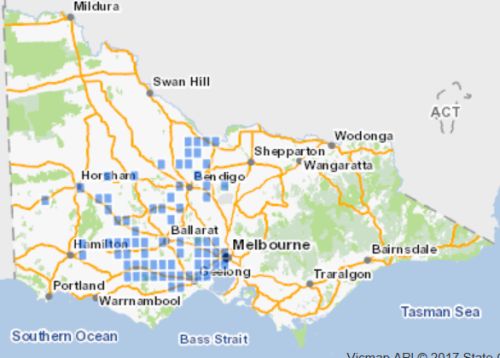
Ecology & Habitat
The Spiny Rice-flower occurs on basalt soils and in areas that received low levels of disturbance often associated with Themeda triandra grasslands. The Spiny Rice-flower slow growing and may live as long as 100 years, flowering occurs from April to August, plants are dioecious (each plant is a either female or male but hermaphrodites have also been recorded).
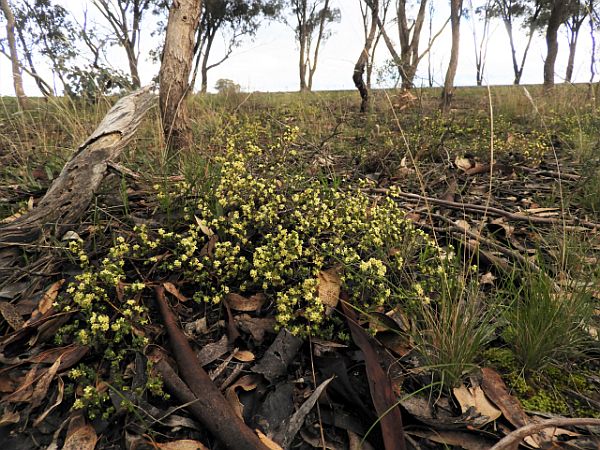
Threats
Weed invasion; primarily from Phalaris and Tall Wheat Grass out compete Spiny Rice-flower for seed bed, germination and sunlight. Weed invasion can be compounded by inappropriate road works and lack of fire. Spiny Rice-flower can benefit from fairly frequent burning as a means of reducing competition for weeds.
Roadworks; soil disturbance which extends beyond the roadside table drain and grading of road reserves for fire breaks can cause physical uprooting of plants or smothering of plants by spreading top soil. Inevitably soil disturbance results in weed invasion as new areas of loose bare soil favour germination from nearby sources of weeds.
Changed land use; conversion of roadside reserves into cropping areas completely removes native species such as Spiny Rice-flower.
Inadequate burning; a high biomass of grasses is a major threat to the Spiny Rice-flower at many sites. Planned burning is an essential tool in managing this species.
Conservation & Management
Conservation of the Spiny Rice-flower is dependent upon co-operation through a number of agencies and conservation organisations who either manage land or undertake conservation activities relating to this species. The overarching direction is via the National Recovery Plan 2024.
- Pimelea Conservation Trust through (Trust for Nature)
- Department of Environment, Land, Water & Planning (DELWP)
- Local Government where the species is known to exist (Melton Shire, Hobsons Bay City, City of Wyndham, City of Brimbank,
- Parks Victoria
- Commonwealth Department of Defence
- VicRoads
- VicUrban (now Places Victoria)
- Cairnlea Grasslands Committee of Management
- Friends Groups/Field Naturalists
A number of sites have been the subject of translocations associated with off-sets through rail, road and urban development which has involved both private and public intersests. Between 2009 and and 2012 at least 11 translocations were undertaken as a result of development activies.
Pimelea Translocation Assessment Report 06.03.14 (9MB)
Demographic monitoring has been used to determine the presence of new germinants in populations of Spiny Rice-flower. This information is considered valuable as the species is slow growing and long lived. There is some concern remaining populations may largely consist of mature individuals with little active recruitment occurring.
For long-term survival it is necessary to successfully germinate seed and employ methods which encourage wild populations to reproduce in situ (Reynolds 2013).
Habitat scoring protocol for the EPBC Act offset calculator
It is important to ensure that impacts to a population and commensurate compensatory offsets are based on the extent of suitable habitat.
Spiny Rice-flower habitat quality scoring
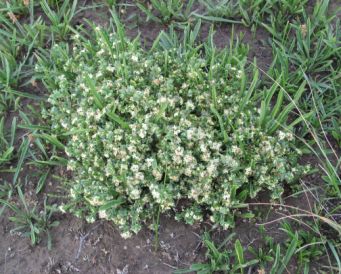
Actions in Corangamite Catchment
Rokewood vicinity
- Identify the area and extent of each population
- Liaise with Golden Plains Shire, CFA and private landholders regarding management.
- In 2011-12 Geggies Rd, Rokewood was monitored to determine the presence of germinants on site. Unfortunately no new germinants were observed (and have not been detected at the site since 2008).
- In 2011-12 a new population of the Spiny Rice-flower was found along Foxhow-Rokewood Road.
Mt Mercer vicinity
- Conduct surveys re; populations on roadsides.
- DELWP to provide assistance to CFA to ensure their current burning regime continues.
- DELWP negotiate a Public Authority Management Agreement under FFG Act.
- Collect seed and send to Royal Botanic Gardens for storage.
- Work with the CFA to spray Phalaris alongside firebreak and allow continued burning.
- Establish quadrats to collect demographic information including recruitment, mortality and timing of life history stages.
Shelford - Mt Mercer Road
Surveys were conducted in 2010-11 by DELWP biodiversity officers and Debbie Reynolds from the Trust for Nature. A 10km stretch of roadside was burnt by the CFA in 2011-12 to reduce biomass which should assist Spiny Rice-flower recovery.
Shelford-Cressy Road
- Liaise with Colac Otway Shire, CFA and private landholders regarding management.
- Difficulty with burning roadsides has meant that some sites are suffering from increased competition from Kangaroo Grass Themeda triandra and other native grasses. Burns are planned to reduce competition.
- Restitution works were carried out by Colac Otway Shire during 2010-11which included weed control. Surveys indicate the Spiny Rice-flower is recovering well.
Foxhow-Rokewood Road
- A new population was discovered by DELWP in the 2011-12 surveys.
Lower Darlington roadside
Surveys during 2011-12 confirmed the presence of Spiny Rice-flower but found the population had substantially reduced from previous surveys (in 2007 over 700 plants down to 382 plants 2011-12). Urgent weed control of Phalaris along fire breaks is being undertaken.
Urches Road
- Identify the area and extent of each population.
- Annual monitoring of threats and population status.
Wingeel vicinity
- Ecological burns undertaken by CFA every 3 years with sites notified by DELWP.
- Monitor site and address weed management priorities to ensure site continues in good condition.
- Collect seed and send to Royal Botanic Gardens for storage.
- Establish quadrats to collect demographic information including recruitment, mortality and timing of life history stages.
- Survey populations and complete VROTPop data forms. In 2010-11 DSE biodiversity officers and Debbie Reynolds from the Trust for Nature conducted surveys.
- Liaise with ARTC, Golden Plains Shire, CFA and private landholders.
Other sites in the Corangamite Catchment
- Signs have been erected by Colac Otway Shire to raise awareness of Spiny Rice-flower at key locations.
- In 2010-11 a previously unrecorded population was identified on the Hamilton Highway west of Cressy.
- A new sub-populations was identified at the Bannockburn Rail Reserve which has resulted in a five-fold increase in plant numbers at that site.
Actions in Wimmera Catchment
Natimuk
- Survey site and weed control, particularly near fire breaks where there has been soil disturbance.
- Hand removal of weeds was undertaken in 2012 with assistance of landholders, follow up planned in 2013.
- Seed collection and propagation. The Royal Botanic Gardens Melbourne collected seed in 2012 which has been propagated at a local native nursery for reintroduction to establish a new site. A plan has been completed and sites have been selected for reintroduction in 2013.
Deep Lead Park Road
- In 2012, damage to a population in the Northern Grampians Shire was rectified by removing top soil which had been placed over plants.
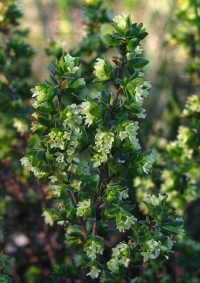
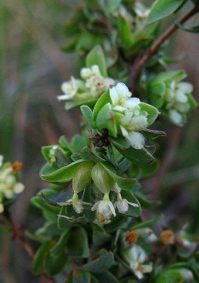
Actions in Glenelg Hopkins Catchment
Blacks Creek Nature Conservation Reserve
- Rabbit and weed control activities planned.
- Surveys for Spiny Rice-flower were conducted during winter 2011.
- In 2012, Parks Victoria conducted weed control over 40ha to reduce Phalaris and thistles.
- In 2012 Parks Victoria established a three year grazing lease along with a long term grazing and burn management plan.
- Parks Victoria conducted a 77 ha mosaic burn in 2012 which provides the necessary ecological requirements for Spiny Rice-flower. It is planned there will be future rotational burns into the future.
Derrinallum area - Chatsworth Road
- Ecological burning is necessary for Pimelea but ongoing monitoring of plants is require to ensure the health of population as this road side is burnt every year by the CFA as it is a strategic fire break.
Skipton Common - Pimelea Conservation Zone
- Ecological/ traditional/ fuel reduction burns undertaken November 2019.
- In May/June 2020, rabbit proof fencing was installed at Skipton Common, around the Pimelea Conservation Zone which is an area managed by the Ballarat Environment Network (BEN). The fencing is aimed at protecting a significant population of the Spiny Rice-flower (Pimelea spinescens subspecies spinescens) estimated to be 1400 plants. Most of the funding was provided by Trust for Nature’s Pimelea Conservation Trust Fund, additional funding was also through GHCMA’s National Landcare Program - Regional Landcare Partnerships grant focused on Spiny Rice-flower conservation. DELWP's “Working for Victoria” Ballarat crew and BEN also provided important in-kind support on the ground.
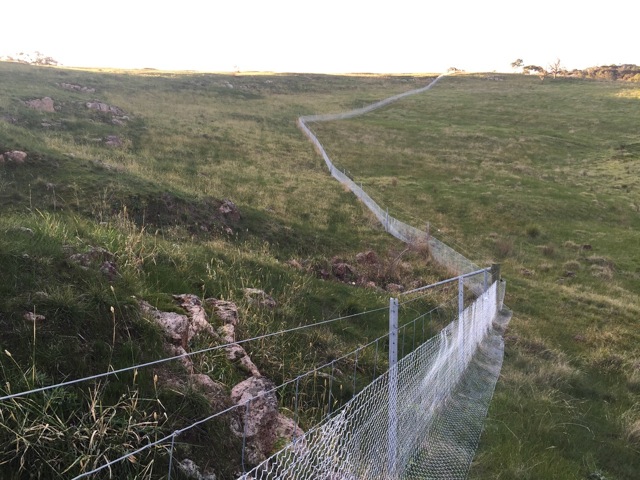
Members from the Ballarat Environment Network have monitored and tagged 1367 Pimelea plants with the total population expected to be around 1400 plants by the time monitoring is completed during winter 2020.
Image: Ballarat Environment Network
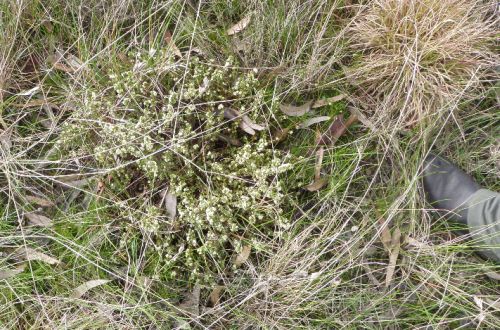
References & Links
Carter, O. & Walsh, N. (2003) Recovery Plan for Pimelea spinescens subsp. spinescens (Spiny Rice-flower) 2004 – 2008. Department of Sustainability and Environment, Heidelberg, Victoria. A Recovery Plan prepared under the Commonwealth Environment Protection and Biodiversity Conservation Act 1999 (unavailable on-line).
FFG (2025) Flora and Fauna Guarantee Act 1988 - Threatened List - March 2025 Department of Energy, Environment and Climate Action (DEECA), Victoria.
1 Lowe, K., Preece, K., Amos, N., (2000) Bioregional Network Analysis. Victorias biodiversity reporting system: a bioregional approach to identifying priorities and partnerships for biodiversity conservation. DSE Victoria.
Reynolds, D. M. 2013. Factors affecting recruitment in populations of Spiny Rice-flower (Pimelea spinescens Rye subspecies spinescens) in Victoria’s natural temperate grasslands: relationships with management practices, biological and ecological characteristics, PhD Thesis, Victoria University, Melbourne. Available online
Walsh, N.G. & Entwisle, T.J. (1996) Flora of Victoria Volume 3: Winteraceae to Myrtaceae, Inkata Press, Melbourne.
VBA (2017) Victorian Biodiversity Atlas, Department of Environment, Land, Water & Planning, Victoria.
More Information
- National Recovery Plan 20 March 2024
- Nomination for listing under EPBC Act 1999
- Pimelea spinescens spinescens Species Profile and Threats database - Department of Environment
- Pimelea spinescens Seed Collection Protocol V5 2018 pdf
- Pimelea spinescens Seed Propagation Protocol June 2009 pdf
- Pimelea spinescens Translocation Protocol March 2013 pdf (1MB) new version added 11 April 2014
- Pimelea spinescens burning recommendations Vl-05.17 pdf
- Pimelea Translocation Assessment Report 06.03.14 (9MB)
- PhD thesis, Debbie Reynolds, Victoria University Research Repository
- Spiny Rice-flower habitat quality scoring
- Grampians Rice-flower
- Wimmera Rice-flower
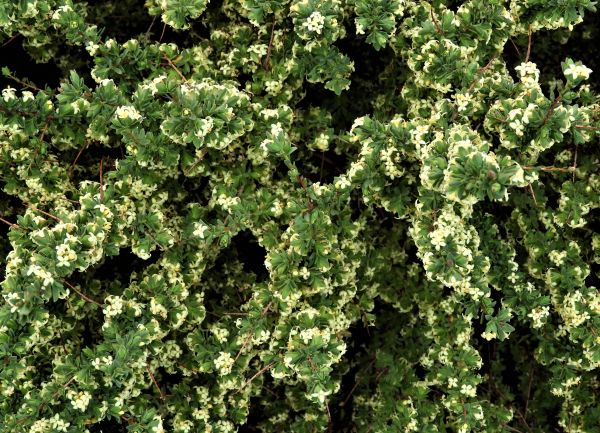
Please contribute information regarding Spiny Rice-flower in Victoria - observations, images or projects. Contact SWIFFT

